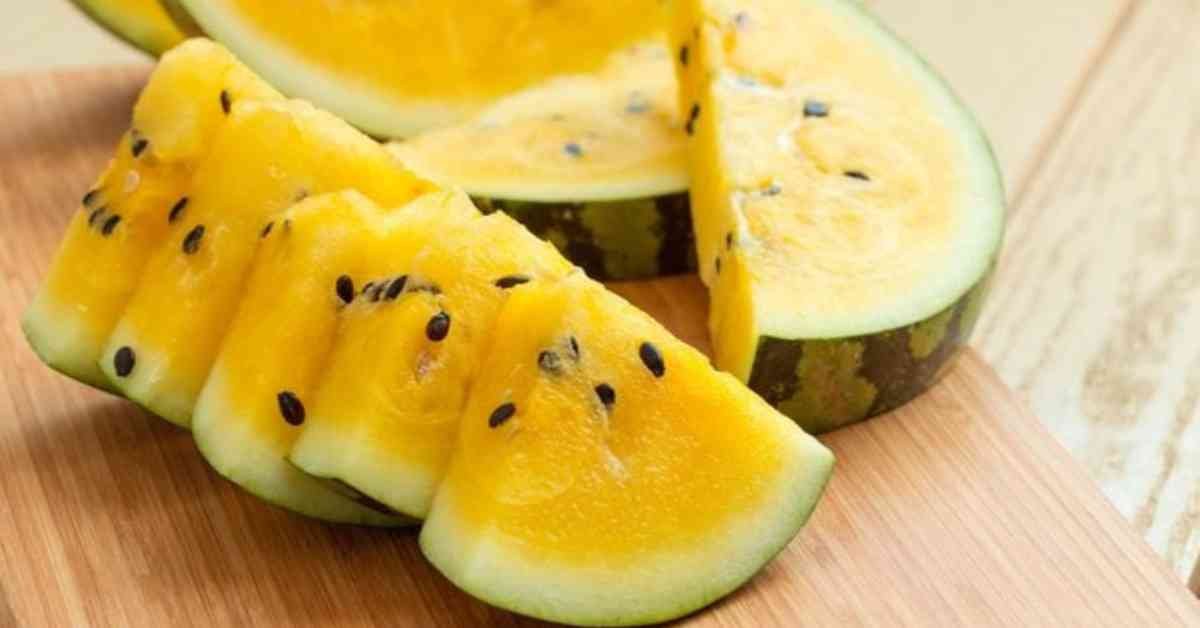Introduction
Yellow Watermelon is synonymous with summer, picnics, and refreshment. The bright red flesh of a watermelon, speckled with black seeds and surrounded by a thick green rind, is an iconic image. However, beyond the familiar red variety, there exists a lesser-known, equally delightful cousin: the yellow watermelon. This article delves into the fascinating world of yellow watermelon, exploring its origins, characteristics, cultivation, nutritional benefits, culinary uses, and much more. By the end of this comprehensive guide, you’ll have a newfound appreciation for this vibrant fruit.
Origins and History
The yellow watermelon (Citrullus lanatus) shares its lineage with the common red watermelon. The origins of watermelons can be traced back to Africa, where wild varieties were found growing in the deserts. These ancient melons were likely consumed for their high water content rather than their flavor. Over centuries, cultivation practices evolved, leading to the development of sweeter, more palatable varieties.
Yellow watermelons are not a recent innovation; they have been around for centuries. Historical records indicate that ancient Egyptians cultivated yellow-fleshed watermelons. The yellow color is a result of a natural mutation that affects the fruit’s pigmentation. While red watermelons get their hue from lycopene, a type of antioxidant, yellow watermelons owe their color to beta-carotene, the same pigment found in carrots and sweet potatoes.
Varieties of Yellow Watermelon
Yellow watermelons come in several varieties, each with its own unique characteristics. Some of the most popular types include:
- Yellow Crimson: This variety is similar in appearance to the traditional Crimson Sweet watermelon but with yellow flesh. It is known for its sweet flavor and crisp texture.
- Buttercup Yellow Melon: Recognized for its round shape and deep yellow flesh, this variety is particularly sweet and juicy.
- Yellow Doll: A smaller, early-maturing variety, the Yellow Doll is perfect for shorter growing seasons. It has a thin rind and exceptionally sweet flesh.
- Yellow Petite: As the name suggests, this variety is small and perfect for individual servings. It is known for its intense sweetness and bright yellow color.
- Desert King: This drought-resistant variety is popular in regions with hot, dry climates. It has a firm texture and a unique, slightly nutty flavor.
Cultivation and Growing Conditions
Growing yellow watermelons is similar to cultivating their red counterparts. They thrive in warm climates and require a long growing season, typically 70 to 90 days from planting to harvest. Here are some key aspects of their cultivation:
Climate and Soil
Yellow watermelons prefer temperatures between 70°F and 85°F (21°C to 29°C). They need full sun to develop their sweet flavor and vibrant color. Well-drained, sandy loam soil with a pH between 6.0 and 7.5 is ideal for their growth. It’s crucial to ensure that the soil is rich in organic matter to provide the necessary nutrients.
Planting
Seeds should be sown directly into the ground after the danger of frost has passed. In cooler climates, starting seeds indoors 2-4 weeks before the last frost date and transplanting them outdoors can give the plants a head start. Plant seeds about 1 inch deep and space them 2-3 feet apart in rows that are 6-8 feet apart to allow ample room for vines to spread.
Watering and Fertilization
Consistent watering is essential, especially during the flowering and fruiting stages. Water deeply but infrequently, allowing the soil to dry slightly between waterings to prevent root rot. Mulching around the base of the plants can help retain moisture and suppress weeds.
Fertilization should be done in stages. At planting time, a balanced fertilizer can be mixed into the soil. Once the vines begin to run, a nitrogen-rich fertilizer will promote vigorous growth. As the plants start to flower and set fruit, switching to a phosphorus and potassium-rich fertilizer will support fruit development.
Pest and Disease Management
Yellow watermelons are susceptible to the same pests and diseases as other melon varieties. Common pests include aphids, cucumber beetles, and squash bugs. Regular inspection and the use of insecticidal soap or neem oil can help manage these pests. Diseases such as powdery mildew, fusarium wilt, and anthracnose can be minimized by practicing crop rotation, ensuring good air circulation, and using resistant varieties.
Harvesting
Yellow watermelons are ready to harvest when they reach their full size, the skin turns dull, and the tendrils near the fruit dry up. Another indicator is the ground spot (the part of the melon resting on the soil) turning from white to a creamy yellow. Carefully cut the fruit from the vine, leaving a few inches of stem attached to prolong shelf life.
Nutritional Benefits
Yellow watermelons are not just a treat for the eyes and taste buds; they also offer numerous health benefits. Here are some key nutritional highlights:
Rich in Antioxidants
Yellow watermelons are packed with antioxidants, particularly beta-carotene, which gives them their vibrant color. Beta-carotene is converted into vitamin A in the body, supporting vision, immune function, and skin health. Additionally, it has anti-inflammatory properties and may help reduce the risk of chronic diseases.
Hydration and Electrolytes
Like all watermelons, yellow watermelons have a high water content (about 90%), making them an excellent choice for hydration. They also contain essential electrolytes such as potassium and magnesium, which are crucial for maintaining fluid balance, muscle function, and nerve signaling.
Low in Calories
Yellow watermelons are low in calories, with approximately 46 calories per cup (152 grams). This makes them a perfect snack for those looking to manage their weight without sacrificing flavor.
Source of Vitamins and Minerals
In addition to vitamin A, yellow watermelons provide vitamins C and B6, both of which support immune function and energy metabolism. They also contain small amounts of minerals like iron and calcium.
Dietary Fiber
While not exceptionally high in fiber, yellow watermelons do contain a small amount that can aid in digestion and promote a feeling of fullness.
Culinary Uses
Yellow watermelons are incredibly versatile and can be used in a variety of culinary applications. Their sweet, honey-like flavor and crisp texture make them a favorite in both sweet and savory dishes. Here are some popular ways to enjoy yellow watermelon:
Fresh and Raw
The simplest and most popular way to enjoy yellow watermelon is to eat it fresh. It can be sliced, cubed, or balled and served as a refreshing snack or dessert. Adding a sprinkle of salt or a squeeze of lime can enhance its natural sweetness.
Salads
Yellow watermelon adds a burst of color and flavor to salads. Combine it with other fruits like berries, grapes, and citrus for a vibrant fruit salad. For a savory twist, pair it with feta cheese, arugula, mint, and a drizzle of balsamic glaze.
Smoothies and Juices
Blend yellow watermelon with other fruits, yogurt, or milk to create delicious and nutritious smoothies. Its high water content also makes it an excellent base for refreshing juices and agua frescas.
Grilled
Grilling yellow watermelon can intensify its sweetness and add a smoky flavor. Slice it into thick rounds or wedges, brush with a little olive oil, and grill for a few minutes on each side. Serve as a side dish or top with herbs and cheese for a unique appetizer.
Sorbets and Popsicles
Yellow watermelon can be pureed and frozen to make delightful sorbets and popsicles. These icy treats are perfect for hot summer days and can be enjoyed by both kids and adults.
Cocktails and Mocktails
Yellow watermelon is a fantastic addition to beverages. Muddle it into cocktails like mojitos and margaritas or mix it into non-alcoholic drinks like lemonade and iced tea for a refreshing twist.
Salsas and Chutneys
Diced yellow watermelon can be used in salsas and chutneys, adding a sweet contrast to spicy ingredients like jalapenos and onions. Serve these condiments with grilled meats, tacos, or as a dip with chips.
Cultural Significance and Popularity
While yellow watermelon is less common than its red counterpart, it holds a special place in various cultures and regions. In Japan, for example, yellow watermelons are prized for their unique appearance and are often given as gifts. In the southern United States, they are a favorite at farmers’ markets and local fairs, celebrated for their exceptional sweetness and novelty.
The popularity of yellow watermelon is steadily increasing as more people become aware of its existence and benefits. Farmers are dedicating more acreage to its cultivation, and seed companies are offering a wider range of yellow watermelon varieties. This growing interest is also reflected in the culinary world, where chefs and food enthusiasts are experimenting with yellow watermelon in creative and unexpected ways.
Growing Yellow Watermelon at Home
For those with a green thumb, growing yellow watermelon at home can be a rewarding experience. Here are some tips for home gardeners:
Selecting Seeds
Choose a variety of yellow watermelon that suits your climate and space. Some popular choices for home gardens include Yellow Doll, Yellow Petite, and Buttercup Yellow Melon. Purchase seeds from a reputable source to ensure quality and viability.
Preparing the Garden
Select a sunny spot in your garden with well-drained soil. If your soil is heavy clay, consider raised beds or amend the soil with compost and sand to improve drainage. Test the soil pH and adjust if necessary to keep it within the optimal range (6.0-7.5).
Planting and Care
Follow the planting guidelines mentioned earlier, spacing seeds or seedlings appropriately to allow for vine growth. Water consistently, especially during dry spells, and apply mulch to retain moisture and reduce weed competition.
Supporting Vines
As the vines grow, you can provide support by training them onto trellises or stakes. This helps keep the fruit off the ground, reducing the risk of pests and diseases. It also makes harvesting easier.
Monitoring and Harvesting
Keep an eye on your watermelon plants for signs of pests or diseases, and address any issues promptly. When the melons are ready to harvest, use the indicators mentioned earlier to determine ripeness. Harvest carefully to avoid damaging the fruit or the plant.
Conclusion
Yellow watermelon is a delightful and nutritious fruit that deserves a spot on your summer menu. Its sweet flavor, vibrant color, and numerous health benefits make it a standout among melons. Whether enjoyed fresh, grilled, blended, or incorporated into creative dishes, yellow watermelon is sure to impress. By understanding its origins, cultivation, and culinary potential, you can fully appreciate and enjoy this sunny gem of the fruit world. So, next time you’re at the market, don’t hesitate to pick up a yellow watermelon and discover its unique charm for yourself.



